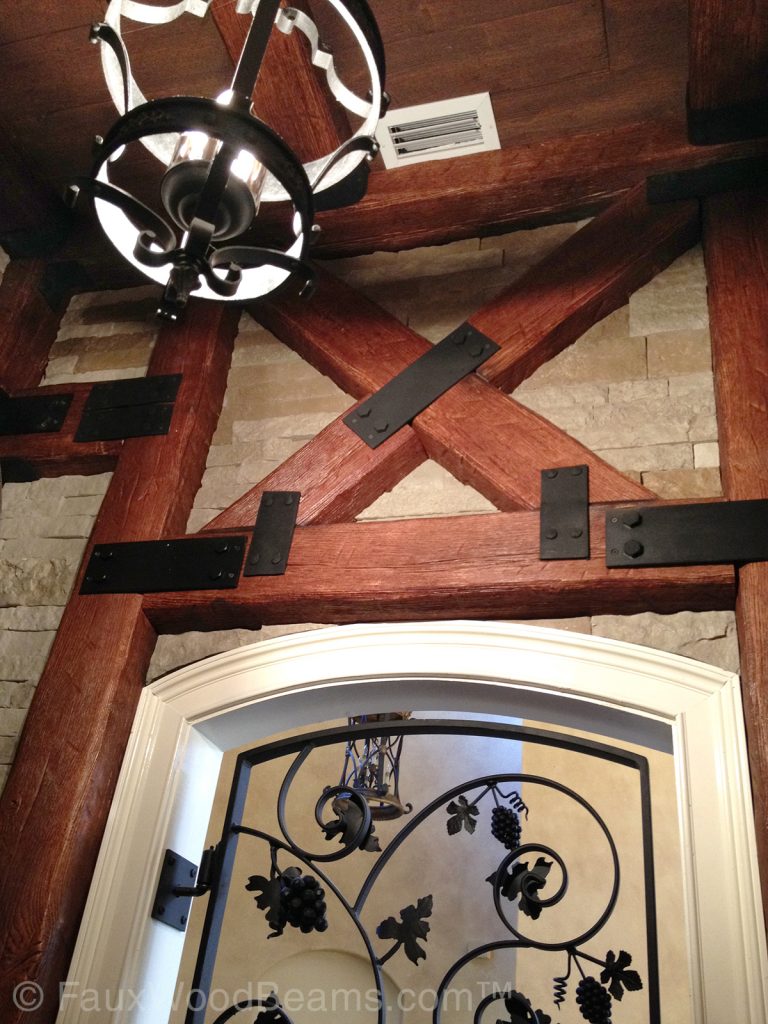
Check out our photo gallery or some of our past blog posts and you'll see some amazing creations built using our faux wood beams. When we talk about those projects, we often refer to how the designers glued certain pieces together to achieve the final look.
But many customers have expressed concern about gluing our beams together - worried that because they're not made of real wood, there might be a reaction to many of the common types of glue available on the market.
In all honesty, that's not a unfair concern to have. Our beams are made from lightweight and durable high density polyurethane foam - and many people have memories of putting glue onto Styrofoam or similar foam substances and watching it melt away.
 This is a great project in which construction adhesive has been used to attach beam straps and secure the beams to each other.
This is a great project in which construction adhesive has been used to attach beam straps and secure the beams to each other.
Well, the good news is that you don't need to worry. First off, we can recommend the best glues to use when building things with our beams. Secondly, we can reassure you that polyurethane foam is actually one of the least-reactive materials available; and safe to use with a wide variety of commercially-available adhesives.
But the concerns aren't unfounded. In fact, a lot of commercially available glues can have some truly unexpected reactions with common household materials. Super glue, for example - known chemically as cyanoacrylate and sold commercially as Scotch-Weld or Loctite - can actually ignite cotton or wool when you combine them; or generate enough heat through a chemical reaction to cause serious burns.
(I learned that the hard way - dripping super glue into my lap while building a model plane!)
Also, check out what super glue does to regular Styrofoam:
https://youtu.be/R3S505rCKCA
That's one of the reasons we chose polyurethane as the material for our[products. As a closed-cell polymer, it's actually resilient to most commercially-available solvents and won't melt when exposed to common adhesives, or paints.
That being said, there are definitely some best-choices that can be made in terms of adhesives, paints and other treatments that you use to finish, decorate and secure your faux wood beams.
We recently wrote about the best choices for painting, staining and coloring faux beams - but in terms of attaching them to each other? Here are the options:
- Screws
When you attach the beams to mounting blocks, we often recommend using traditional wood screws; and our beams are perfect for that. The dense polyurethane foam is easy to drill into, and secures screws tightly; ensuring a snug, permanent bond.
However, there are reasons why this isn't great for attaching one beam to another - especially because foam can crumble and once a screw has been disturbed or dislodged, it often ruins the screw-hole (and leaves a hole in the beam.)
That's why I'd recommend using screws only for final attachment, and then only into a solid material underneath like a wooden mounting block. If you're going to want to remove the beams at any point, try a more resilient option like using magnets.
- Wood glue
What you know of as Wood Glue or Elmer's Glue is the delicious white stuff we used to eat at pre-school (wait, what do you mean that was just me?) It's actually called Polymer glue, and is a versatile type of adhesive that is especially good for gluing (you guessed it) wood. That's because it actually seeps into the porous surface of wood to really create a secure bond.
That being said, wood glue is not the perfect choice for gluing our beams. It has its uses, sure, but the way it dries - into a clear, white and shiny bond - isn't always the best-looking or most versatile finish.
- Construction adhesive
There are a variety of different products sold as 'construction adhesive' but all are generally a good match for using with our beams. Some are polyurethane-based themselves, while others are made from similar materials.
Depending on the type of adhesive you buy, it can work especially well with our faux products. Check the spec sheet to see if the glue is 'foaming' or 'non-foaming'. Foaming means it expands after application; which can be great when you're touching up spots like old drill holes - but not so great when you're trying to seamlessly join two beams.
Our beams help keep your options open, and that gives you a world of possibilities to explore. Whether you're building a truss, attaching corbels, or applying beam straps, you have a good range of materials to help you achieve your goals; and our beams are durable enough to support all of them.
If you have any tips or hints you've discovered during your faux wood beam projects, don't be shy - let us know about them in the comments section below. Even after all these years, we're still learning new ways in which people are using our products; and we're always eager to share what we learn here.
 Because real corbels are poking through the surface of the wall, our faux corbels have to not show any obvious attachment points. That's why attaching them with construction adhesive is a good option.
Because real corbels are poking through the surface of the wall, our faux corbels have to not show any obvious attachment points. That's why attaching them with construction adhesive is a good option.



